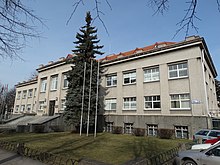Agriculture of Lithuania

The Lithuanian agriculture is a branch of the Lithuanian economy . The Lithuanian Ministry of Agriculture is responsible for national policy and the National Land Office for land reform .
history
Land reform took place in Lithuania between 1919 and 1936 . Agriculture was by far the most important branch of the economy after the First World War . 79% of the population worked in agriculture in 1923. Before the war, 10% of the agricultural land was Russian crown land . Between 35 and 40% of the area was owned by landowners, the rest belonged to smallholders. The farm properties had an average size of 12 to 13 hectares, the goods about 400 hectares. As part of the land reform, 745,000 hectares of agricultural land were redistributed. The size of the goods was limited to 80 hectares. 38,000 landless people received land, and 26,000 smallholders received additional land. In the end, the share of smallholders in the land area had risen from 60 to 85%. The land reform contributed to the fact that the cultivation of grain declined in favor of animal husbandry.
In 1923 the export of grain was started with excess grain. In 1926 Lithuania had 209 sausage and canning factories. In 1939, 722,000 tons of rye, 436,000 tons of oats and 267,000 tons were produced in Lithuania. Tons of barley, 260,000 tons of wheat, 235,000 tons of potatoes, 62,000 tons of flax and 59,000 tons of peas. The Lithuanian white pig was bred in Lithuania .
Associations
After a restructuring of the Lietuvos žemės ūkio draugija (Association for Agriculture of Lithuania), founded in Kaunas in 1921 , the Lietūkis Association was established. With the support of the government, Lietūkis became the largest association of cooperatives. In 1927 he founded the Central Union of the Lithuanian Dairy Companies Pienocentras .
Organizations
education
- Aleksandras Stulginskis University
- Veterinary Academy of the University of Health Sciences of Lithuania
- Faculty of Landscape Studies of the Kaunas College
- Technical center for hydromelioration Panevėžys
Personalities
- Konrad von Dressler President of the Memelland Chamber of Agriculture
Web links
Individual evidence
- ^ Gerhard Willoweit: The economic history of the Memel area, Vol. 2, pp. 507-508


